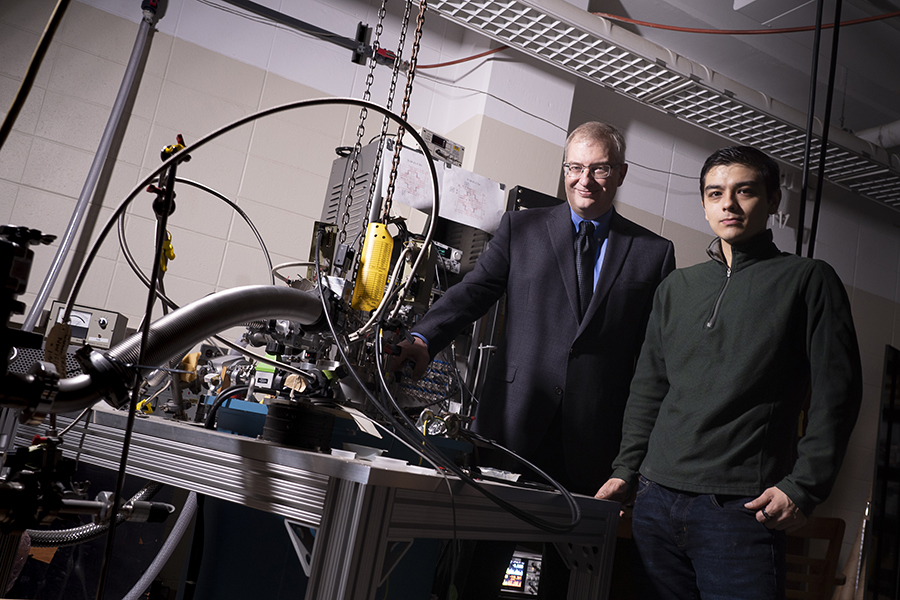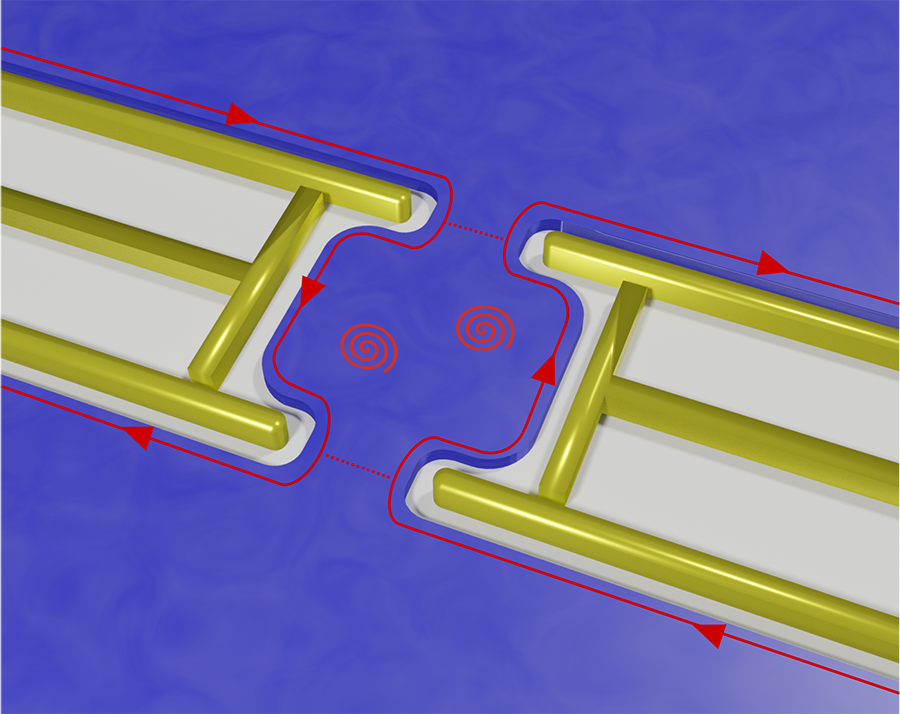Purdue physicists develop experimental techniques to expose various flavors of anyons
2023-10-23

Unlike fermions (electrons) and bosons (photons), anyons come in a wide variety of flavors depending on the electronic ground state that generates them. Though these flavors do not relate to the sense of taste, anyonic flavors refer to the charge and statistics of a particular anyon; these unique properties may facilitate a wide range of technological breakthroughs in quantum physics. Physicists at Purdue University have developed experimental techniques and analysis that is sensitive to a variety of different flavors of anyons and have published their results this week in Physical Review X.
Anyons are a fundamentally new type of excitation that exists in nature. The existence of anyons was predicted over 40 years ago by Nobel Laureate Frank Wilczek and applied to the fractional quantum Hall effect by Bert Halperin and other theoretical physicists. The team at Purdue created excitement in 2020 when they captured the first direct evidence of anyonic braiding. Then they took that research further by developing and applying new techniques to probe anyons at the n=1/3 fractional quantum Hall state under a variety of experimental conditions. And now, they have applied their technique to the more complex higher order fractional quantum Hall state n=2/5. This is an important step as the fragility and complexity of n=2/5 make the team’s interferometry technique difficult to apply.
Anyons are emergent particles that exist in two-dimensional systems. The fundamental physics community is interested in these particles because they offer differing statistical properties than the more commonly observed bosons and fermions.
According to Dr. Michael Manfra, certain types of anyons may find utility in future generations of quantum device technology. Manfra is the Bill and Dee O’Brien Distinguished Professor of Physics and Astronomy, Professor of Electrical and Computer Engineering, Professor of Materials Engineering, and the Scientific Director of the Microsoft Quantum Lab West Lafayette.
“In this work we have extended our interferometry techniques that we used in 2020 to report the first observations of anyon braiding. In this most recent experiment, we demonstrated that anyons may be observed not only at the principal n=1/3 fractional quantum Hall state, but also at more complex higher order fractional quantum Hall states such as n=2/5,” says Manfra. “The reason this demonstration at n=2/5 is important is that it shows the measurement technique is general and may be used to probe even more exotic quasiparticles in future experiments. The anyons at n=2/5 have different properties than the anyons at n=1/3 and our experimental technique is sensitive to these differences.”
The team consists of Dr. James Nakamura, graduate student Shuang Liang, Dr. Geoffrey Gardner, and Manfra. The experiment was conducted by Nakamura with supervision and contribution to interpretation by Manfra. Liang and Gardner contributed to the experiment with materials growth crucial to the experiment’s success.
Their findings with anyons at the higher order fractional quantum Hall effect state at 2/5 filling factor is a major step forward in the use of Fabry-Perot interferometry to expose anyons in condensed matter systems. The extension of the measurements from 1/3 to 2/5 was non-trivial and required significant changes and more advanced analysis. According to Manfra, these new measurements really point to the versatility of the technique.
“We now have a technique that is sensitive to the variety of different anyonic flavors,” explains Manfra. “With this in mind, we have hope that we will be able to harness the different types of anyons for specific experimental goals. The experimental technique may also be used to detect anyons in different experimental settings, not just in the GaAs/AlGaAs devices we explore in the fractional quantum Hall regime. If this is true, the technique may have broad utility.”

Purdue University is uniquely positioned to conduct this type of research and experimentation due to its high-tech facilities and experts in the field of quantum semiconductor systems.
“The key is that we have all the necessary ingredients for success here in my group at Purdue,” says Manfra. “We design and grow the AlGaAs/GaAs heterostructures that are unique and necessary to conduct the experiments, we fabricate the nanoscale devices in the cleanroom at the Birck Nanotechnology Center, and we have the ultra-low temperature electrical measurement capabilities necessary to measure tiny interference signals at temperatures down to T=10mK, nearly absolute zero, in my quantum transport laboratory in the basement of the Physics building. All three aspects occur in-house; this integration is the source of our success.”
The Manfra Group sees this work as a stepping stone in a multi-phase era of discovery. Only in the last few years have physicists been able to have direct experimental access to these exotic particles.
“Our experiments are part of this exciting new field of research,” says Manfra. “In the future, it may be possible to harness another type of anyon – called a non-Abelian anyon – for use in computer technology. This goal is aspirational, but the combination of profound fundamental physics and potential for future technology is hard to beat at the moment. It makes the field exciting and fun.”
This work was supported by the U.S. Department of Energy, Office of Science, Office of Basic Energy Sciences, under Award No. DE-SC0020138.
RELATED NEWS:
- Physicists have ‘braided’ strange quasiparticles called anyons
- Researchers at Purdue University demonstrate bulk-edge coupling of anyons
- New evidence that the quantum world is even stranger than we thought
About the Department of Physics and Astronomy at Purdue University
Purdue Department of Physics and Astronomy has a rich and long history dating back to 1904. Our faculty and students are exploring nature at all length scales, from the subatomic to the macroscopic and everything in between. With an excellent and diverse community of faculty, postdocs, and students who are pushing new scientific frontiers, we offer a dynamic learning environment, an inclusive research community, and an engaging network of scholars.
Physics and Astronomy is one of the seven departments within the Purdue University College of Science. World-class research is performed in astrophysics, atomic and molecular optics, accelerator mass spectrometry, biophysics, condensed matter physics, quantum information science, and particle and nuclear physics. Our state-of-the-art facilities are in the Physics Building, but our researchers also engage in interdisciplinary work at Discovery Park District at Purdue, particularly the Birck Nanotechnology Center and the Bindley Bioscience Center. We also participate in global research including at the Large Hadron Collider at CERN, many national laboratories (such as Argonne National Laboratory, Brookhaven National Laboratory, Fermilab, Oak Ridge National Laboratory, the Stanford Linear Accelerator, etc.), the James Webb Space Telescope, and several observatories around the world.
About Purdue University
Purdue University is a public research institution with excellence at scale. Ranked among top 10 public universities and with two colleges in the top 4 in the United States, Purdue discovers and disseminates knowledge with a quality and at a scale second to none. More than 105,000 students study at Purdue across modalities and locations, with 50,000 in person on the West Lafayette campus. Committed to affordability and accessibility, Purdue’s main campus has frozen tuition 12 years in a row. See how Purdue never stops in the persistent pursuit of the next giant leap, including its first comprehensive urban campus in Indianapolis, the new Mitchell E. Daniels, Jr. School of Business, and Purdue Computes, at https://www.purdue.edu/president/strategic-initiatives.
Contributors:
Michael Manfra, Bill and Dee O’Brien Distinguished Professor of Physics and Astronomy, Professor of Electrical and Computer Engineering, Professor of Materials Engineering, and the Scientific Director of the Microsoft Quantum Lab West Lafayette.
James Nakamura, Senior Research Scientist
Written by Cheryl Pierce, Communications Specialist